Lat Krabang, Bangkok, Thailand
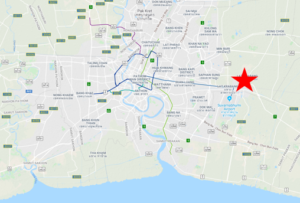
Central Thailand’s agricultural lands—a mosaic of rice paddies, fish ponds, and pastures, divided by canals, dykes, and hedgerows—are rich in birdlife, especially during migration and winter when wetland and grassland birds from throughout eastern Asia join the resident breeders. Bangkok’s most accessible rice basket is Lat Krabang, adjacent to the new, ultramodern Suvarnabhumi Airport. Although urban sprawl is slowly but inexorably overrunning the habitat and degrading what remains, several species that are rare or sporadic in Bangkok’s city parks are fairly easy to find here, including Cinnamon Bittern, Bronze-winged Jacana, Oriental Pratincole, several bush-warblers, Red Avadavat, and White-rumped Munia.
Orientation
Directions
Lat Krabang is a large district on the outskirts of metropolitan Bangkok, about 30 km east of downtown. Some parts of it are readily accessible by mass transit, but most are not. Because it is a large area where conditions vary over both time and distance, it is generally preferable to explore by car. However, it is also possible to see many species using only public transportation.
By Rail. The Airport Rail Link has a Lat Krabang station—the last one before the airport—which gives access to the western side of Lat Krabang.
There are in addition, two commuter rail stations in Lat Krabang—called Pra Chom Klao and Hua Takhe—but the service is infrequent and would require consulting the timetables.
By Road. The main route across Lat Krabang is Thanon Chalong Krung. From most points in Bangkok, the best way to reach it is to take Highway 7, the Chon Buri Expressway, toward Suvarnabhumi Airport, and exit onto the Frontage Road about 2 km before reaching the airport exit.
Continue eastbound on the Frontage Road, making any necessary deviations to get past the airport interchange. About 3 km past the airport, bear left onto Thanon Chalong Krung, following the signs toward Nong Chok.
Thanon Chalong Krung is a divided highway that anchors a corridor of development that cuts across Lat Krabang and Nong Chok. There are several side-roads that quickly lead into the agricultural lands that comprise most of the territory of these districts.
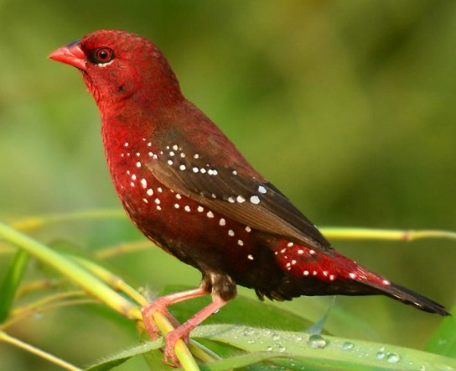
Red Avadavat is generally scarce in Bangkok but fairly common around Lat Krabang. © Mayureshl Khatavkar
The first side-road leads into the village Wat Suthapot, where there is a well-explored area that is productive for birds. Many other parts of Lat Krabang are probably equally productive or better, so almost any of the side-roads along Thanon Chalong Krung could be worth exploring.
Birdfinding
Lat Krabang is a large district, and most of it is potentially productive for birds, so this report barely covers only a tiny fraction of the alternatives. Two accessible areas are: (1) Sam Canal, for visitors who wish to use mass transit, and (2) Wat Sutaphot.
Sam Canal. The most convenient portion of Lat Krabang to explore via mass transit and foot power is a canal that is denoted on maps as “Sam,” with a concrete walkway called Rom Klao 25/5 beside it. The canal and walkway lead north from the Airport Rail Link station for about 10 km to its junction with a larger canal.
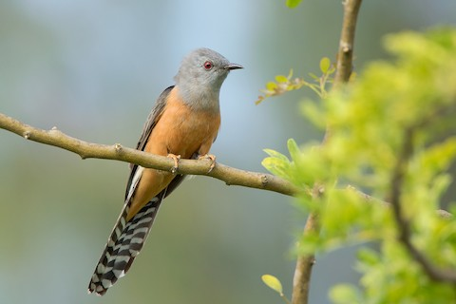
Plaintive Cuckoo is very common along Sam Canal in Lat Krabang. © Ayuwat Jearwattanakanok
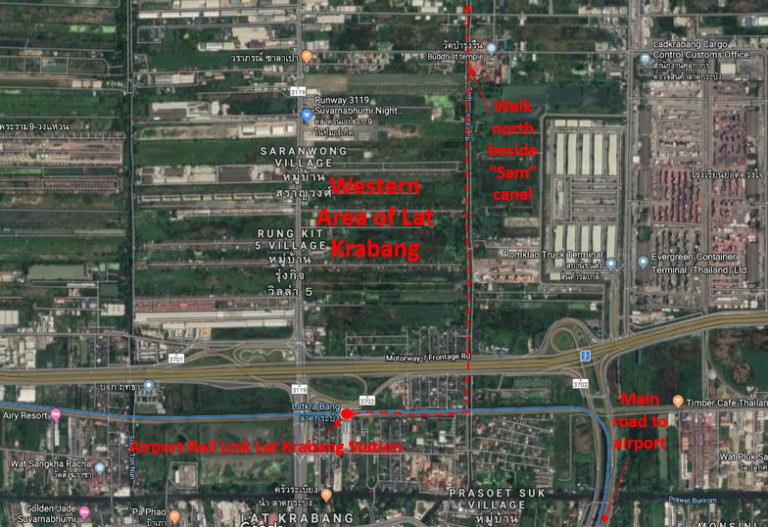
To reach the canal on foot from the Airport Rail Link’s Lat Krabang station, walk east across the parking lot and continue on the path along the commuter railroad for a further 400 m. The main walkway (Rom Klao 25/5) follows the western side of the canal, but there is also a walkway on the eastern for several sections. Farther north, the canal has a single walkway, sometimes on the western side, sometimes on the eastern side.
Walking the canal should produce a good sample of common countryside birds. Red Collared-Dove is abundant, and Plaintive Cuckoo can be very common, as the canal evidently provides a favored foraging habitat.
(See Hazards & Hassles below for cautionary notes on dogs along the canal.)
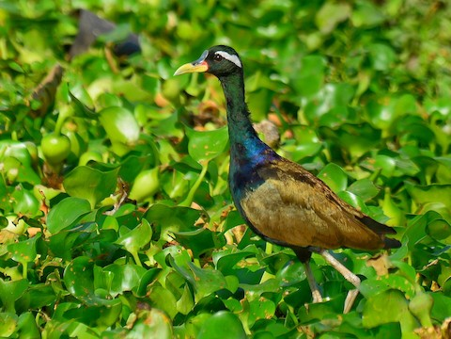
The beautiful Bronze-winged Jacana is common at Lat Krabang, and can usually be found along Sam Canal. © Renuka Vijayaraghavan
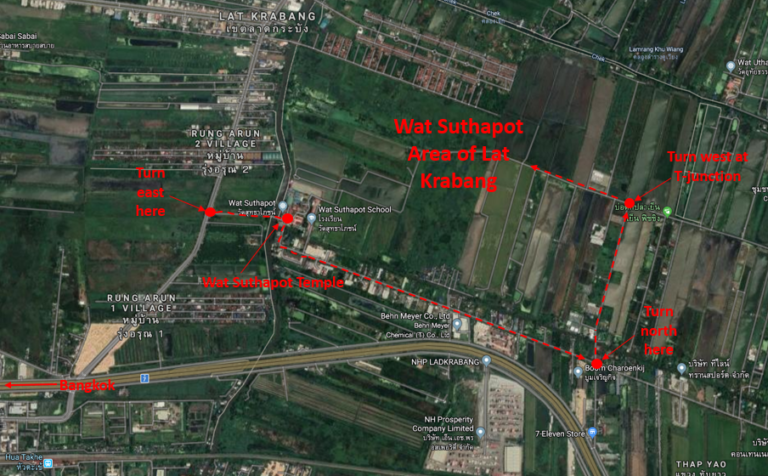
Wat Suthapot. Once on Thanon Chalong Krung northbound from Highway 7, go about 1 km and turn right at the traffic light. This side road becomes a bridge over a canal, then immediately arrives at the main gate to the Wat Suthapot temple.
Follow the road as it bends right, crosses another bridge, then bends left and becomes Liap Khlong Mon Road. After about 2 km, turn sharply left onto Saribut Road, and go 1 km to the T-junction.
Turn left at the junction to enter a quiet zone of rice paddies and dry fields, followed by a more natural area with ponds, marshes, and brush. Most of the birds reported from Lat Krabang can be found here.

White-rumped Munia is very common in the fields around Wat Suthapot. © Neoh Hor Kee
Species that occur regularly at Lat Krabang, but are much less common within the Bangkok metropolitan area, include: Lesser Whistling-Duck, Spot-billed Pelican, Cinnamon and Black Bitterns, Purple Heron, Black-headed Ibis, Eastern Marsh and Pied Harriers, Watercock, White-browed and Ruddy-breasted Crakes, Bronze-winged and Pheasant-tailed Jacanas, Oriental Pratincole, Greater Coucal, Yellow-bellied Prinia, Dusky and Thick-billed Warblers, Black-browed and Oriental Reed-Warblers, Pallas’s Grasshopper-Warbler, Baikal Bush-Warbler, Bluethroat, Siberian Rubythroat, Asian Pied and Chestnut-tailed Starlings, Baya and Asian Golden Weavers, White-rumped and Chestnut Munias, Red Avadavat, and Plain-backed Sparrow.
Notes
Hazards & Hassles
Beware of Dogs!
Some parts of Lat Krabang, especially near the rural-urban interface—including much of Sam Canal—are plagued by innumerable barking, growling, snapping dogs. Many of these are guard dogs kept by a homeowner or business to discourage intruders; but many appear to be disowned and running feral. They can be extremely annoying, while a sizeable minority appear to be truly dangerous—that is, they actively threaten to bite—and in some instances they gather in packs of a dozen or more.
As in many other rural areas of central Thailand, it is advisable to carry a stick, or better yet a telescoping baton, or two—and keep a few throwing rocks in your pockets—to discourage dogs from bothering you. Ideally, the visitor should be prepared to actually use such weapons, at least as a follow-up to shouting back at the dogs. In most cases, the dogs will lose interest, or the associated humans will restrain them, after an initial encounter.